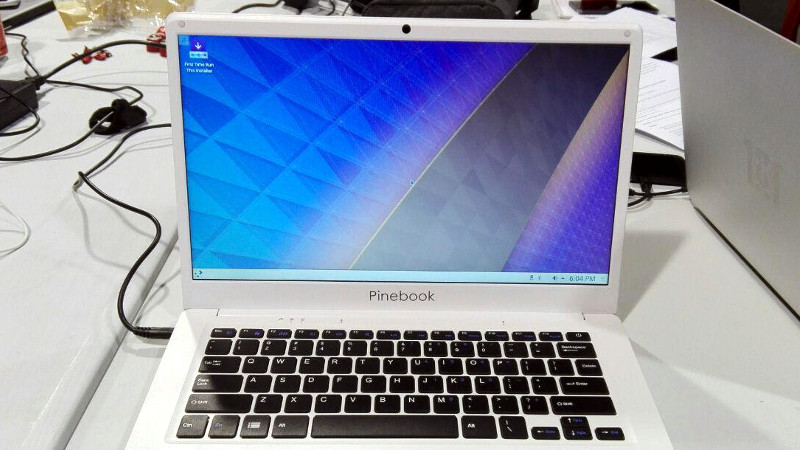If you’re the kind of person who likes small and cheap Linux devices, you’re definitely alive in the perfect moment in history. It seems as if every few months we’ve got another tiny Linux board competing for our pocket change, all desperate to try to dethrone the Raspberry Pi which has already set the price bar exceptionally high (or low, as the case may be). We’ve even started to see these Linux boards work their way into appropriately cheap laptops, though so far none have really made that great of an impression.
 But thanks to the efforts of Blue Systems and Pine64, the situation might be improving: they’ve worked together on a build of KDE Neon for the $99 Pinebook. The fact that they’ve gotten Plasma, KDE’s modern desktop environment, running on the rather mediocre hardware at all is an accomplishment by itself. But they’ve also set out tailor the entire system for the Pinebook, from the kernel and graphics drivers all the way up to Qt and Plasma tweaks.
But thanks to the efforts of Blue Systems and Pine64, the situation might be improving: they’ve worked together on a build of KDE Neon for the $99 Pinebook. The fact that they’ve gotten Plasma, KDE’s modern desktop environment, running on the rather mediocre hardware at all is an accomplishment by itself. But they’ve also set out tailor the entire system for the Pinebook, from the kernel and graphics drivers all the way up to Qt and Plasma tweaks.
In a blog post announcing the release candidate of the OS, Neon developer [Jonathan Riddell] says that these top-to-bottom improvements show that you can turn a super cheap Linux laptop into a practical computer if you’re willing to really get in there and optimize it. He also says the project has been something of a two-way street, in that improvements made for the Pinebook build have also been applied to upstream development.
The last time we looked at the Pinebook, we came away cautiously optimistic. It wasn’t great, but it was about as good as you could possibly expect given the price. If more developers are willing to go out on a limb and start optimizing their software for the device, it might become a very promising platform for low-cost mobile hacking.















Does someone want a notebook, that runs a stone old kernel (3.10, probably borrowed from Android), and that you actually can’t buy?
I’d be more interested to know what OS I could use effortlessly on an eeePC 701 4Gb…
mine cant event use an os properly because the onboard SSD has been too much used. kernel panics, random buggs….
anyway to change it ? love this computer… first netbook i had…
Could use an external SD. Or the PCI Express slot if it’s still populated. I’ve never seen the onboard-only model.
Yup, at least on the 901 it was possible, I upgraded the ‘internal’ SSD from 4 to a whopping 32 GB.
where did you get the drive?
my 900 has a weird flexitrack IDE cable, I’ve been looking for an embiggend drive to make it dual boot
Used too much ? Thats near impossible. 701 uses SLC flash good for around 100k rewrites (modern day ssds are good for ~1-3k rewrites) so thats definitely not it.
Wasn’t the 701 very limited also wrt RAM? Constant swapping by a wrongly tuned fs could be the culprit.
@ytrewq
Not likely. While 701 did only have 512mb of ram stock, it was sooo slow, it would take ages to degrade.
If you’re good with a soldering iron you could put a USB memory inside.
I did that and more back in the day. It’s been a while.
https://www.sweclockers.com/galleri/2619-uppgraderad-asus-eee (Swedish)
Aside from choosing something with a relatively small footprint; the only special measure you will probably have to take is using forcepae.
If memory serves the Celeron m 353 in that thing is Dothan-based, and so should support PAE; but is from the period where properly declaring support for PAE wasn’t yet routine; so a PAE kernel(which is most of the contemporary distros 32-bit builds) allowed to autodetect will probably freak out.
I’m running Ubuntu Netbook remix, which is a bitch, there is not enough space to upgrade
I mainly use it in confined spaces or up the top of ladders to download Arduino sketches
only having a 4G flash I’m going to install Puppy
http://puppylinux.org/wikka/EeePC
running the live boot is fast! these days running Arduino or Processing is easy
JoliOS or heh heh Moblin.
I did have luck with Puppy Linux and it ran fine with win7 and an SSD when I gave it to my mom. On the third machine but same hdd/ram. YMMV
BunsenLabs is my favorite lightweight moden Debian based distro and should work fine with the eeePC 701. If you need even lighter for really old hardware, give SliTaz a try–it’s helped me to put a modern firefox on ancient hardware.
NetBSD has good support for it, and is completely modern.
I pre(?)ordered 2 of the larger pinebooks in august-2017 and never got any answer since then…
Maybe I get an email in 2061…
Hm, I have two of the 14 inch ones right here. So they do exist.
Wow!
nice
This article should have a title “Unobtanium gets KDE Neon port”.
Surplus computers are available worldwide for a better price point,
The HP 14″ laptop with quad core Intel i5, 8 gig ram, 500 gig HD, webcam, sells for $150.00
Yes, they are crippled with Windows, but they will run quite well on Linux.
I was able to pick up a couple of HP “Convertible” Laptop/Tablet computers for $25 without the SSD drive.
A 80 gig SSD was picked up for $10, so all was well. HP had all the drivers for Windows 7, and Wacom made the screen.with “Pencil” on a cord.
I don’t know if Linux supports the Wacom tablet..
Before you ask, http://www.siliconsalvage.com ask for Dan.
Yeah… but… HP.
I’ve had nothing but bad experiences with HP computers.
Not me!
I run our lab on HP Refurbs – maybe a dozen in service there and another three at home. We’ve had one fail, ever, and it was replaced within the week under warranty. It may be that the really bad ones disappear and never get into the refurb stream.
I don’t see what hackaday/”the community” doesn’t use these and old phones more – cheap, lotsa processor, and often high level programming and self-powered (for phones & laptops). I/O is a pain sometimes but so is the $5 RPi.
By “these” I mean salvaged computers that aren’t up to this weeks artificial performance metric – there are certainly plenty out there.
Closed, in almost every sense of the word.
Lenovo x220/x230 are in similar price range, $150 will get you slick i5 laptop.
That brings up an interesting question.
I hate to ask how “free” it is, since that’s become both a loaded and ambiguous term, so instead:
Are they using proprietary firmware for things like wifi? Proprietary graphics drivers?
What’s the situation with TrustZone and signing?
Are they taking the steps to deblob their (vanilla?) kernels?
Can you run the system without non-free packages? (actually, do they have a decent repo? I assume it’s a custom distro)
Bonus round: Do they have a sans-systemd version? ;D
Yeah, mee to. I literaly had one die on me while reinstalling Windows.
Why no pass-through referral link? Even used car lots sell inventory online these days.
Advertising for used computer (lots?) should at least not require “calling Dan” so he can talk to his day manager and get you a “special deal”.
I’m actually curious why anyone would set it up like that. Better margin?
Looking at the link, you may see the ebay postings, And “Dan” is the laptop guy, and Dave is the tower guy.
Most of the refurbs are marketed direct at the “TRW Swap Meet”, last Saturday of every month. (In L.A.)
Held by the ham radio group http://w6trw.com/index.php/w6trw-amateur-radio-club-swap-meet/
They normally stock HP, Dell Toshiba, and Lenovo. The refurb channel is almost always a “Business Class” machine.
Not a “Best Buy Plastic” junk. And no, I’m not on commission..
I don’t mean to inhibit you, but the HP Z800 workstation Dual Quad Xeon, 2 TB drive 24 gig ram,
Windows 7 Pro is more.
It goes for $200.00
“If you’re the kind of person who likes small and cheap Linux devices…”
Pogo and Guru-plug.
Small and cheap?
I’ve been able to get them cheap. Headless mine you, although supposedly there was one recalled Guru model (heat issues).
Linux on inexpensive phones? Not Android bloatware please.
I bought a Dell Inspiron 11 for something like $170 and put Lubuntu on it. Not without a bit of a struggle though…
same kinda thing here, snagged the inspiron 15 for like 300 bucks on clearance (usually 400 but was a display model so no box included) The LTS of ubuntu was a little tricky to get running on it back then. later versions of LTS have fixed alot of that though.
It would be great if you could actually buy one for 99$. Import charges to EU and 37$ shipping makes this closer the the price of a chromebook.
I really wish chinese would start cloning these and selling them cheaper or at least in higher quantities.
China already clones the MacBook Air, Amazon for $140 USD
anything cheaper that that ? ;)
Actually, they were cheaper until youtube posted reviews, jumped up from $99 to $140.
Maybe direct from source would be cheaper still..
If I wanted a Mac, I’d build a “Hackntosh” out of a HP or Lenovo.
Armbian has polished Bionic with 3.10.y and preview version with kernel 4.18.y which is not really for daily use yet. https://www.armbian.com/pinebook-a64/